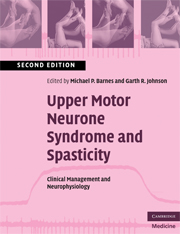Book contents
- Frontmatter
- Contents
- List of Contributors
- Preface to the second edition
- 1 An overview of the clinical management of spasticity
- 2 Neurophysiology of spasticity
- 3 The measurement of spasticity
- 4 Physiotherapy management of spasticity
- 5 Seating and positioning
- 6 Orthoses, splints and casts
- 7 Pharmacological management of spasticity
- 8 Chemical neurolysis in the management of muscle spasticity
- 9 Spasticity and botulinum toxin
- 10 Intrathecal baclofen for the control of spinal and supraspinal spasticity
- 11 Surgical management of spasticity
- 12 Management of spasticity in children
- Index
- References
3 - The measurement of spasticity
Published online by Cambridge University Press: 22 August 2009
- Frontmatter
- Contents
- List of Contributors
- Preface to the second edition
- 1 An overview of the clinical management of spasticity
- 2 Neurophysiology of spasticity
- 3 The measurement of spasticity
- 4 Physiotherapy management of spasticity
- 5 Seating and positioning
- 6 Orthoses, splints and casts
- 7 Pharmacological management of spasticity
- 8 Chemical neurolysis in the management of muscle spasticity
- 9 Spasticity and botulinum toxin
- 10 Intrathecal baclofen for the control of spinal and supraspinal spasticity
- 11 Surgical management of spasticity
- 12 Management of spasticity in children
- Index
- References
Summary
Introduction
Even today, although there are a number of validated techniques for the measurement of associated disability, the measurement of spasticity at the level of impairment is probably in its infancy. Because of the relative lack of treatment or therapy to reduce spasticity, there has been limited development of methods for its measurement. However, with the relatively recent advent of treatments for spasticity, such as botulinum toxin, there is now a considerable incentive to develop new methods.
One particular barrier to valid measurement relates to the need for a precise definition. The measurement of any physical phenomenon is impossible in the absence of a definition, and this is equally true in the case of spasticity. At the clinical level, there is almost certainly a wide variety of assumed definitions concerning stiffness and the lack or difficulty of movement. A relatively precise statement has been provided by Lance (1980), as follows: Spasticity, which is directly equated with spastic hypertonia, is a motor disorder that is ‘characterised by a velocity dependent increase in the tonic stretch reflex (muscle tone) with exaggerated tendon reflexes, resulting from the hyper excitability of the stretch reflex, as one component of the upper motor neurone syndrome’ following a lesion at any level of the corticofugal pathways – cortex, internal capsule, brainstem or spinal cord (Burke, 1988). Furthermore, spastic hypertonia has also been described as the exaggeration of the spinal proprioceptive reflexes resulting from a loss of descending inhibitory control (Burke, 1988).
- Type
- Chapter
- Information
- Upper Motor Neurone Syndrome and SpasticityClinical Management and Neurophysiology, pp. 64 - 78Publisher: Cambridge University PressPrint publication year: 2008
References
- 1
- Cited by

